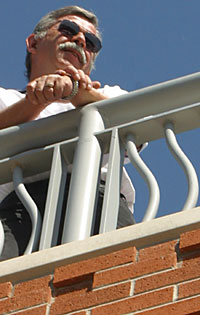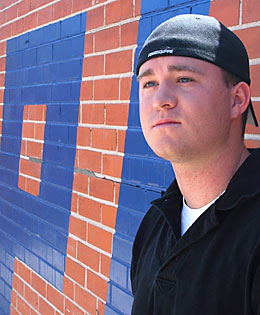 |
|
DAVID HARDEN/Arizona Daily Wildcat
|
Budget director Dick Roberts looks over the Integrated Learning Center last week. The debt for the ILC is paid off by tuition dollars.
|
|
By Keren G. Raz
Arizona Daily Wildcat
Monday April 7, 2003
15 percent of students' tuition dollars allocated to service debt on university building projects
Every semester thousands of UA students travel to the Bursar's office to pay their tuition. After signing their check, they shut their checkbooks and leave the Bursar's office behind them.
As they walk past the Integrated Learning Center and the Main Library with its fifth floor addition, they might not know that about 15 percent of the check they just handed over to the university helps pay off the debt on the construction of these buildings.
That percent translates into about $375 per year for resident students and about $1,600 per year for out-of-state students.
This connection between buildings and tuition prompted UA student activists to present a list of demands to the Arizona Board of Regents at the tuition hearings just over a month ago.
As part of their demands, the activists said they could only support a tuition increase if administrators froze campus construction.
With this demand, they raised a question that has been on students' minds since administrators proposed a $1,000 tuition increase, the largest in UA history.
"How can administrators say there is not enough money to run the university and then spend millions of dollars on new buildings such as the Student Union Memorial Center?" they asked.
Although tuition dollars have not directly paid for the construction of the student union or any other building on campus, they do play a crucial role in paying off the debt on projects such as the ILC, the library's high-tech asement.
Since 1995, administrators have allocated over 10 percent of each year's tuition revenue to pay off the debt for construction projects. For at least two decades, administrations have chosen to use tuition money for debt payments.
President Pete Likins has continued that tradition even as state budget cuts make available funds more valuable than ever.
 |
|
WILL SEBERGER/Arizona Daily Wildcat
|
Dave Downey, communication junior, has been unable to register for the classes he needs in order to graduate on time.
|
|
A competition for tuition dollars
Dave Downey lives in the Pi Kappa Alpha fraternity house, only a few blocks away from the University Medical Center and the future site of the Roy Drachman Hall, a building that will house state-of-the-art instructional facilities for the College of Nursing, Pharmacy and Public Health.
Administrators have proposed to pay off the Roy Drachman Hall debt with tuition dollars because it will be used primarily for instruction.
But as a communication junior who will not benefit from Drachman Hall, Downey said he disagrees with administration's decision.
He said the university should prioritize the needs of current students over buildings, and right now he said the university needs to ensure its students are graduating on time.
Downey said he won't be able to finish in four years because budget cuts have forced too many classes to be cancelled.
"It just seems ridiculous that we have 30,000 students at school, and a lot of them are looking at five years because they're cutting class size and losing teachers," he said.
Over the past two years, the university has cancelled 231 of its undergraduate classes as a result of the budget cuts.
In addition, the budget cuts in 2002 forced administrators to lay off 144 university employees and close the Arizona International College, according to a document released in July 2002.
But around that same time, the amount of tuition revenue allocated for debt service rose from $14 million to $20.6 million due to a number of new construction projects, such as the utility infrastructure for the residence halls on North Highland Avenue, said Dick Roberts, director of the budget office.
Roberts said he uses the $20.6 million not only to pay off new projects but also to pay off projects dating back to 1982, including the Gould-Simpson building from 1982 and the Aerospace and Mechanical Engineering building from 1994.
Administrations have been choosing to allocate tuition money tuition money toward debt service for a long time, Roberts said.
But those decisions that were made in the past are no longer appropriate to make today as the university faces cuts in state funding, said Rachel Wilson, a UA activist and speech and hearing research technician.
Wilson spoke at a roundtable discussion on Focused Excellence two months ago about what she called the hidden connection between buildings and tuition.
That connection, she said, prevented her from supporting the proposed tuition increase.
She said she has a problem with today's administration paying for new buildings while everyone else suffers from budget cuts.
"It's been a strange focus on building," she said. "We're in a severe budget crunch, and maybe we should delay building these buildings awhile."
But Provost George Davis said that there has to be an emphasis on securing more space because some people are studying in buildings with less-than-ideal conditions. He points to the Architecture building where students spill out in the hallway to work on their final projects at the end of the year.
"From a policy point of view, we try to determine where there's most pressure for a need," Davis said. "Pathetic space would be a reason."
Robert Leyen, a third year architecture student, couldn't agree more with the administration's decision to prioritize buildings as an immediate need.
Although he was one of only a few people in the Architecture building last week, he was still surrounded by piles of projects left behind by students after they had left for the day.
"Look around, it's really cramped," he said, turning back to his desk, one of the only desks not piled high with stacks of paper and cardboard.
With at least eight new building projects proposed for the near future, campus reconstruction remains a high priority on administration's "to fund" list.
And every choice to invest in the future look of campus comes at a more immediate cost.
"There's more demand than what you can satisfy given the resources you've got," Roberts said.
But Downey said with $20 million worth of students' tuition paying off debt rather than helping them receive their education in four years, the university has its priorities all wrong.
"It seems a bit ridiculous that a school that emphasizes finishing in four years cannot even dish out what they are shoveling," he said.
Downey points to a larger question that administrators have to grapple with in times of severe budget cuts: Where do the university's priorities lie ÷ with students who need to graduate or with the future of the university?
Where the priorities lie
In the basement of the Administration building, six floors below the president's office, Roberts is surrounded by budget books that track every dollar coming through the university.
"Guys like me are trained to look at the university as a whole rather than the university as a collection of individuals," Roberts said.
Not even Likins as president of UA or Davis as chair of the finance committee can dig through the complexity of university financing to know the specific color of each dollar spent at the UA.
So it's Roberts, just walking distance away from the ILC, who has to find the money to satisfy the thousands of demands that administrators face everyday.
Even in times of budget constraints, the yearly debt payments are critical for the university, Roberts said. As mandated by state law, the university cannot take on a debt greater than 8 percent of the $1.2 billion operating budget.
This year the university spends $52 million to pay off debt or about 4 percent of its budget.
If new buildings are constructed, the amount of tuition money allocated for debt service must increase in order for the university to stay under the state's cap.
"What we're always trying to find is the right equilibrium · between marginal scarce resources," Roberts said. "I try to figure out what's the most efficient move to get the president where he needs to be," he said.
As the administrator who won't let any dollar slip out of sight, Roberts helps decide how tuition plays into the president's vision, which has construction as a centerpiece.
There are proposals for five new construction projects on the table, which include the Roy Drachman Hall, the architecture expansion, the chemistry addition, the poetry center, and the utility infrastructure for the Arizona Health Sciences Center.
The amount of tuition dollars allocated for debt service will probably go up in order to pay for these projects, Roberts said.
These new projects, with the exception of the utility infrastructure, have a common thread running through them: how many tuition dollars are used rests on how much of the building is used for instruction.
Because the chemistry addition will also create additional research space, tuition dollars will only constitute a small part of the funds used to pay off the debt service, Roberts said.
On the other hand, tuition might be the only source of funds used toward the debt service for the architecture expansion because the building's focus on instruction does not bring in revenue as parking fees bring in revenue for parking structures and grants bring in revenue for research buildings.
"For us this addition has very little research space. It's primarily instruction, so the obvious source to pay off debt is tuition," said Richard Eribes, dean of the College of Architecture, Planning and Landscape Architecture.
Even if administrators decide to eliminate the School of Landscape Architecture and the School of Planning, Eribes said the Architecture building must still expand in order to give its students more space.
"Right now it's inhumane," he said.
But Matt Huntsberger, a pre-business freshman, said classes for students ought to be prioritized above any construction.
"When they have enough money to pay for classes that people are taking, then they should be building stuff," he said. "God knows how many projects we have going on."
Regardless of whether Huntsberger thinks paying off the debt on buildings is the best use for tuition money, the fact remains that the new buildings popping up around campus and students' tuition are connected.
"We receive money and pay it back with tuition money," Davis said.

